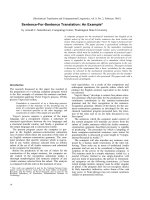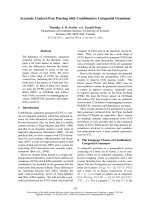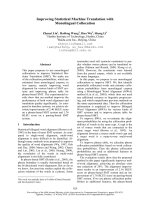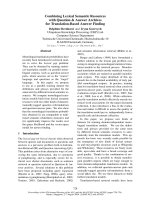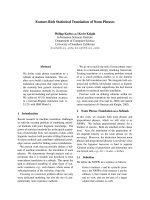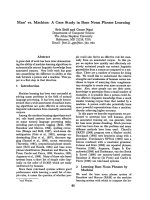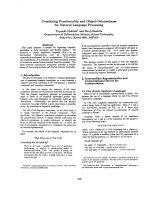Báo cáo khoa học: "Combining Morpheme-based Machine Translation with Post-processing Morpheme Prediction" ppt
Bạn đang xem bản rút gọn của tài liệu. Xem và tải ngay bản đầy đủ của tài liệu tại đây (309.44 KB, 11 trang )
Proceedings of the 49th Annual Meeting of the Association for Computational Linguistics, pages 32–42,
Portland, Oregon, June 19-24, 2011.
c
2011 Association for Computational Linguistics
Combining Morpheme-based Machine Translation with
Post-processing Morpheme Prediction
Ann Clifton and Anoop Sarkar
Simon Fraser University
Burnaby, British Columbia, Canada
{ann clifton,anoop}@sfu.ca
Abstract
This paper extends the training and tun-
ing regime for phrase-based statistical ma-
chine translation to obtain fluent trans-
lations into morphologically complex lan-
guages (we build an English to Finnish
translation system). Our methods use
unsupervised morphology induction. Un-
like previous work we focus on morpho-
logically productive phrase pairs – our
decoder can combine morphemes across
phrase boundaries. Morphemes in the tar-
get language may not have a corresponding
morpheme or word in the source language.
Therefore, we propose a novel combina-
tion of post-processing morphology pre-
diction with morpheme-based translation.
We show, using both automatic evaluation
scores and linguistically motivated analy-
ses of the output, that our methods out-
perform previously proposed ones and pro-
vide the best known results on the English-
Finnish Europarl translation task. Our
methods are mostly language independent,
so they should improve translation into
other target languages with complex mor-
phology.
1 Translation and Morphology
Languages with rich morphological systems
present significant hurdles for statistical ma-
chine translation (SMT), most notably data
sparsity, source-target asymmetry, and prob-
lems with automatic evaluation.
In this work, we propose to address the prob-
lem of morphological complexity in an English-
to-Finnish MT task within a phrase-based trans-
lation framework. We focus on unsupervised
segmentation methods to derive the morpholog-
ical information supplied to the MT model in
order to provide coverage on very large data-
sets and for languages with few hand-annotated
resources. In fact, in our experiments, unsuper-
vised morphology always outperforms the use
of a hand-built morphological analyzer. Rather
than focusing on a few linguistically motivated
aspects of Finnish morphological behaviour, we
develop techniques for handling morphological
complexity in general. We chose Finnish as our
target language for this work, because it ex-
emplifies many of the problems morphologically
complex languages present for SMT. Among all
the languages in the Europarl data-set, Finnish
is the most difficult language to translate from
and into, as was demonstrated in the MT Sum-
mit shared task (Koehn, 2005). Another reason
is the current lack of knowledge about how to ap-
ply SMT successfully to agglutinative languages
like Turkish or Finnish.
Our main contributions are: 1) the intro-
duction of the notion of segmented translation
where we explicitly allow phrase pairs that can
end with a dangling morpheme, which can con-
nect with other morphemes as part of the trans-
lation process, and 2) the use of a fully seg-
mented translation model in combination with
a post-processing morpheme prediction system,
using unsupervised morphology induction. Both
of these approaches beat the state of the art
on the English-Finnish translation task. Mor-
phology can express both content and function
categories, and our experiments show that it is
important to use morphology both within the
translation model (for morphology with content)
and outside it (for morphology contributing to
fluency).
Automatic evaluation measures for MT,
BLEU (Papineni et al., 2002), WER (Word
Error Rate) and PER (Position Independent
Word Error Rate) use the word as the basic
unit rather than morphemes. In a word com-
32
prised of multiple morphemes, getting even a
single morpheme wrong means the entire word is
wrong. In addition to standard MT evaluation
measures, we perform a detailed linguistic anal-
ysis of the output. Our proposed approaches
are significantly better than the state of the art,
achieving the highest reported BLEU scores on
the English-Finnish Europarl version 3 data-set.
Our linguistic analysis shows that our models
have fewer morpho-syntactic errors compared to
the word-based baseline.
2 Models
2.1 Baseline Models
We set up three baseline models for compari-
son in this work. The first is a basic word-
based model (called Baseline in the results);
we trained this on the original unsegmented
version of the text. Our second baseline is a
factored translation model (Koehn and Hoang,
2007) (called Factored), which used as factors
the word, “stem”
1
and suffix. These are de-
rived from the same unsupervised segmenta-
tion model used in other experiments. The re-
sults (Table 3) show that a factored model was
unable to match the scores of a simple word-
based baseline. We hypothesize that this may
be an inherently difficult representational form
for a language with the degree of morphologi-
cal complexity found in Finnish. Because the
morphology generation must be precomputed,
for languages with a high degree of morpho-
logical complexity, the combinatorial explosion
makes it unmanageable to capture the full range
of morphological productivity. In addition, be-
cause the morphological variants are generated
on a per-word basis within a given phrase, it
excludes productive morphological combination
across phrase boundaries and makes it impossi-
ble for the model to take into account any long-
distance dependencies between morphemes. We
conclude from this result that it may be more
useful for an agglutinative language to use mor-
phology beyond the confines of the phrasal unit,
and condition its generation on more than just
the local target stem. In order to compare the
1
see Section 2.2.
performance of unsupervised segmentation for
translation, our third baseline is a segmented
translation model based on a supervised segmen-
tation model (called Sup), using the hand-built
Omorfi morphological analyzer (Pirinen and Lis-
tenmaa, 2007), which provided slightly higher
BLEU scores than the word-based baseline.
2.2 Segmented Translation
For segmented translation models, it cannot be
taken for granted that greater linguistic accu-
racy in segmentation yields improved transla-
tion (Chang et al., 2008). Rather, the goal in
segmentation for translation is instead to maxi-
mize the amount of lexical content-carrying mor-
phology, while generalizing over the information
not helpful for improving the translation model.
We therefore trained several different segmenta-
tion models, considering factors of granularity,
coverage, and source-target symmetry.
We performed unsupervised segmentation of
the target data, using Morfessor (Creutz and
Lagus, 2005) and Paramor (Monson, 2008), two
top systems from the Morpho Challenge 2008
(their combined output was the Morpho Chal-
lenge winner). However, translation models
based upon either Paramor alone or the com-
bined systems output could not match the word-
based baseline, so we concentrated on Morfes-
sor. Morfessor uses minimum description length
criteria to train a HMM-based segmentation
model. When tested against a human-annotated
gold standard of linguistic morpheme segmen-
tations for Finnish, this algorithm outperforms
competing unsupervised methods, achieving an
F-score of 67.0% on a 3 million sentence cor-
pus (Creutz and Lagus, 2006). Varying the per-
plexity threshold in Morfessor does not segment
more word types, but rather over-segments the
same word types. In order to get robust, com-
mon segmentations, we trained the segmenter
on the 5000 most frequent words
2
; we then used
this to segment the entire data set. In order
to improve coverage, we then further segmented
2
For the factored model baseline we also used the
same setting perplexity = 30, 5,000 most frequent words,
but with all but the last suffix collapsed and called the
“stem”.
33
Training Set Test Set
Total 64,106,047 21,938
Morph 30,837,615 5,191
Hanging Morph 10,906,406 296
Table 1: Morpheme occurences in the phrase table
and in translation.
any word type that contained a match from the
most frequent suffix set, looking for the longest
matching suffix character string. We call this
method Unsup L-match.
After the segmentation, word-internal mor-
pheme boundary markers were inserted into
the segmented text to be used to reconstruct
the surface forms in the MT output. We
then trained the Moses phrase-based system
(Koehn et al., 2007) on the segmented and
marked text. After decoding, it was a sim-
ple matter to join together all adjacent mor-
phemes with word-internal boundary markers
to reconstruct the surface forms. Figure 1(a)
gives the full model overview for all the vari-
ants of the segmented translation model (super-
vised/unsupervised; with and without the Un-
sup L-match procedure).
Table 1 shows how morphemes are being used
in the MT system. Of the phrases that included
segmentations (‘Morph’ in Table 1), roughly a
third were ‘productive’, i.e. had a hanging mor-
pheme (with a form such as stem+) that could
be joined to a suffix (‘Hanging Morph’ in Ta-
ble 1). However, in phrases used while decoding
the development and test data, roughly a quar-
ter of the phrases that generated the translated
output included segmentations, but of these,
only a small fraction (6%) had a hanging mor-
pheme; and while there are many possible rea-
sons to account for this we were unable to find
a single convincing cause.
2.3 Morphology Generation
Morphology generation as a post-processing step
allows major vocabulary reduction in the trans-
lation model, and allows the use of morpholog-
ically targeted features for modeling inflection.
A possible disadvantage of this approach is that
in this model there is no opportunity to con-
sider the morphology in translation since it is
removed prior to training the translation model.
Morphology generation models can use a vari-
ety of bilingual and contextual information to
capture dependencies between morphemes, of-
ten more long-distance than what is possible us-
ing n-gram language models over morphemes in
the segmented model.
Similar to previous work (Minkov et al., 2007;
Toutanova et al., 2008), we model morphology
generation as a sequence learning problem. Un-
like previous work, we use unsupervised mor-
phology induction and use automatically gener-
ated suffix classes as tags. The first phase of our
morphology prediction model is to train a MT
system that produces morphologically simplified
word forms in the target language. The output
word forms are complex stems (a stem and some
suffixes) but still missing some important suffix
morphemes. In the second phase, the output of
the MT decoder is then tagged with a sequence
of abstract suffix tags. In particular, the out-
put of the MT decoder is a sequence of complex
stems denoted by x and the output is a sequence
of suffix class tags denoted by y. We use a list
of parts from (x,y ) and map to a d-dimensional
feature vector Φ(x, y), with each dimension be-
ing a real number. We infer the best sequence
of tags using:
F (x) = argmax
y
p(y | x, w)
where F(x ) returns the highest scoring output
y
∗
. A conditional random field (CRF) (Lafferty
et al., 2001) defines the conditional probability
as a linear score for each candidate y and a global
normalization term:
log p(y | x, w) = Φ(x, y) · w − log Z
where Z =
y
∈GEN(x)
exp(Φ(x, y
) · w). We
use stochastic gradient descent (using crfsgd
3
)
to train the weight vector w. So far, this is
all off-the-shelf sequence learning. However, the
output y
∗
from the CRF decoder is still only a
sequence of abstract suffix tags. The third and
final phase in our morphology prediction model
3
/>34
Morphological Pre-Processing
English Training Data Finnish Training Data
words
stem+ +morph
words
Post-Process:
Morph Re-Stitching
stem+ +morph
Evaluation against
original reference
Fully inflected surface form
MT System
Alignment:
word word word
stem+ +morph stem
(a) Segmented Translation Model
MT System
Alignment:
word word word
stem+ +morph1+ stem
Morphological Pre-Processing 1
English Training Data Finnish Training Data
words
stem+ +morph1+
words
Post-Process 1:
Morph Re-Stitching
stem+ +morph1+
Post-Process 2: CRF
Morphology Generation
complex stem: stem+morph1+
Language Model
surface form mapping
stem+morph1+ +morph2
Evaluation against
original reference
Fully inflected surface form
Morphological Pre-Processing 2
stem+ +morph1+ +morph2
(b) Post-Processing Model Translation & Generation
Figure 1: Training and testing pipelines for the SMT models.
is to take the abstract suffix tag sequence y
∗
and
then map it into fully inflected word forms, and
rank those outputs using a morphemic language
model. The abstract suffix tags are extracted
from the unsupervised morpheme learning pro-
cess, and are carefully designed to enable CRF
training and decoding. We call this model CRF-
LM for short. Figure 1(b) shows the full pipeline
and Figure 2 shows a worked example of all the
steps involved.
We use the morphologically segmented train-
ing data (obtained using the segmented corpus
described in Section 2.2
4
) and remove selected
suffixes to create a morphologically simplified
version of the training data. The MT model is
trained on the morphologically simplified train-
ing data. The output from the MT system is
then used as input to the CRF model. The
CRF model was trained on a ∼210,000 Finnish
sentences, consisting of ∼1.5 million tokens; the
2,000 sentence Europarl test set consisted of
41,434 stem tokens. The labels in the output
sequence y were obtained by selecting the most
productive 150 stems, and then collapsing cer-
tain vowels into equivalence classes correspond-
ing to Finnish vowel harmony patterns. Thus
4
Note that unlike Section 2.2 we do not use Unsup
L-match because when evaluating the CRF model on the
suffix prediction task it obtained 95.61% without using
Unsup L-match and 82.99% when using Unsup L-match.
variants -k¨o and -ko become vowel-generic en-
clitic particle -kO, and variants -ss¨a and -ssa
become the vowel-generic inessive case marker
-ssA, etc. This is the only language-specific com-
ponent of our translation model. However, we
expect this approach to work for other agglu-
tinative languages as well. For fusional lan-
guages like Spanish, another mapping from suf-
fix to abstract tags might be needed. These suf-
fix transformations to their equivalence classes
prevent morphophonemic variants of the same
morpheme from competing against each other in
the prediction model. This resulted in 44 possi-
ble label outputs per stem which was a reason-
able sized tag-set for CRF training. The CRF
was trained on monolingual features of the seg-
mented text for suffix prediction, where t is the
current token:
Word Stem s
t−n
, , s
t
, , s
t+n
(n = 4)
Morph Prediction y
t−2
, y
t−1
, y
t
With this simple feature set, we were able to
use features over longer distances, resulting in
a total of 1,110,075 model features. After CRF
based recovery of the suffix tag sequence, we use
a bigram language model trained on a full seg-
mented version on the training data to recover
the original vowels. We used bigrams only, be-
cause the suffix vowel harmony alternation de-
pends only upon the preceding phonemes in the
word from which it was segmented.
35
original training data:
koskevaa mietint¨o¨a k¨asitell¨a¨an
segmentation:
koske+ +va+ +a mietint¨o+ +¨a k¨asi+ +te+ +ll¨a+ +¨a+ +n
(train bigram language model with mapping A = { a, ¨a })
map final suffix to abstract tag-set:
koske+ +va+ +A mietint¨o+ +A k¨asi+ +te+ +ll¨a+ +¨a+ +n
(train CRF model to predict the final suffix)
peeling of final suffix:
koske+ +va+ mietint¨o+ k¨asi+ +te+ +ll¨a+ +¨a+
(train SMT model on this transformation of training data)
(a) Training
decoder output:
koske+ +va+ mietint¨o+ k¨asi+ +te+ +ll¨a+ +¨a+
decoder output stitched up:
koskeva+ mietint¨o+ k¨asitell¨a¨a+
CRF model prediction:
x = ‘koskeva+ mietint¨o+ k¨asitell¨a¨a+’, y = ‘+A +A +n’
koskeva+ +A mietint¨o+ +A k¨asitell¨a¨a+ +n
unstitch morphemes:
koske+ +va+ +A mietint¨o+ +A k¨asi+ +te+ +ll¨a+ +¨a+ +n
language model disambiguation:
koske+ +va+ +a mietint¨o+ +¨a k¨asi+ +te+ +ll¨a+ +¨a+ +n
final stitching:
koskevaa mietint¨o¨a k¨asitell¨a¨an
(the output is then compared to the reference translation)
(b) Decoding
Figure 2: Worked example of all steps in the post-processing morphology prediction model.
3 Experimental Results
For all of the models built in this paper, we used
the Europarl version 3 corpus (Koehn, 2005)
English-Finnish training data set, as well as the
standard development and test data sets. Our
parallel training data consists of ∼1 million sen-
tences of 40 words or less, while the develop-
ment and test sets were each 2,000 sentences
long. In all the experiments conducted in this
paper, we used the Moses
5
phrase-based trans-
lation system (Koehn et al., 2007), 2008 version.
We trained all of the Moses systems herein using
the standard features: language model, reorder-
ing model, translation model, and word penalty;
in addition to these, the factored experiments
called for additional translation and generation
features for the added factors as noted above.
We used in all experiments the following set-
tings: a hypothesis stack size 100, distortion
limit 6, phrase translations limit 20, and maxi-
mum phrase length 20. For the language models,
we used SRILM 5-gram language models (Stol-
cke, 2002) for all factors. For our word-based
Baseline system, we trained a word-based model
using the same Moses system with identical set-
tings. For evaluation against segmented trans-
lation systems in segmented forms before word
reconstruction, we also segmented the baseline
system’s word-based output. All the BLEU
scores reported are for lowercase evaluation.
We did an initial evaluation of the segmented
output translation for each system using the no-
5
/>Segmentation m-BLEU No Uni
Baseline 14.84±0.69 9.89
Sup 18.41±0.69 13.49
Unsup L-match 20.74±0.68 15.89
Table 2: Segmented Model Scores. Sup refers to the
supervised segmentation baseline model. m-BLEU
indicates that the segmented output was evaluated
against a segmented version of the reference (this
measure does not have the same correlation with hu-
man judgement as BLEU). No Uni indicates the seg-
mented BLEU score without unigrams.
tion of m-BLEU score (Luong et al., 2010) where
the BLEU score is computed by comparing the
segmented output with a segmented reference
translation. Table 2 shows the m-BLEU scores
for various systems. We also show the m-BLEU
score without unigrams, since over-segmentation
could lead to artificially high m-BLEU scores.
In fact, if we compare the relative improvement
of our m-BLEU scores for the Unsup L-match
system we see a relative improvement of 39.75%
over the baseline. Luong et. al. (2010) report
an m-BLEU score of 55.64% but obtain a rel-
ative improvement of 0.6% over their baseline
m-BLEU score. We find that when using a
good segmentation model, segmentation of the
morphologically complex target language im-
proves model performance over an unsegmented
baseline (the confidence scores come from boot-
strap resampling). Table 3 shows the evalua-
tion scores for all the baselines and the methods
introduced in this paper using standard word-
based lowercase BLEU, WER and PER. We do
36
Model BLEU WER TER
Baseline 14.68 74.96 72.42
Factored 14.22 76.68 74.15
(Luong et.al, 2010) 14.82 - -
Sup 14.90 74.56 71.84
Unsup L-match 15.09
∗
74.46 71.78
CRF-LM 14.87 73.71 71.15
Table 3: Test Scores: lowercase BLEU, WER and
TER. The ∗ indicates a statistically significant im-
provement of BLEU score over the Baseline model.
The boldface scores are the best performing scores
per evaluation measure.
better than (Luong et al., 2010), the previous
best score for this task. We also show a bet-
ter relative improvement over our baseline when
compared to (Luong et al., 2010): a relative im-
provement of 4.86% for Unsup L-match com-
pared to our baseline word-based model, com-
pared to their 1.65% improvement over their
baseline word-based model. Our best perform-
ing method used unsupervised morphology with
L-match (see Section 2.2) and the improvement
is significant: bootstrap resampling provides a
confidence margin of ±0.77 and a t-test (Collins
et al., 2005) showed significance with p = 0.001.
3.1 Morphological Fluency Analysis
To see how well the models were doing at get-
ting morphology right, we examined several pat-
terns of morphological behavior. While we wish
to explore minimally supervised morphological
MT models, and use as little language spe-
cific information as possible, we do want to
use linguistic analysis on the output of our sys-
tem to see how well the models capture essen-
tial morphological information in the target lan-
guage. So, we ran the word-based baseline sys-
tem, the segmented model (Unsup L-match),
and the prediction model (CRF-LM) outputs,
along with the reference translation through the
supervised morphological analyzer Omorfi (Piri-
nen and Listenmaa, 2007). Using this analy-
sis, we looked at a variety of linguistic construc-
tions that might reveal patterns in morphologi-
cal behavior. These were: (a) explicitly marked
noun forms, (b) noun-adjective case agreement,
(c) subject-verb person/number agreement, (d)
transitive object case marking, (e) postposi-
tions, and (f) possession. In each of these cat-
egories, we looked for construction matches on
a per-sentence level between the models’ output
and the reference translation.
Table 4 shows the models’ performance on the
constructions we examined. In all of the cat-
egories, the CRF-LM model achieves the best
precision score, as we explain below, while the
Unsup L-match model most frequently gets the
highest recall score.
A general pattern in the most prevalent of
these constructions is that the baseline tends
to prefer the least marked form for noun cases
(corresponding to the nominative) more than
the reference or the CRF-LM model. The base-
line leaves nouns in the (unmarked) nominative
far more than the reference, while the CRF-LM
model comes much closer, so it seems to fare
better at explicitly marking forms, rather than
defaulting to the more frequent unmarked form.
Finnish adjectives must be marked with the
same case as their head noun, while verbs must
agree in person and number with their subject.
We saw that in both these categories, the CRF-
LM model outperforms for precision, while the
segmented model gets the best recall.
In addition, Finnish generally marks di-
rect objects of verbs with the accusative
or the partitive case; we observed more
accusative/partitive-marked nouns following
verbs in the CRF-LM output than in the base-
line, as illustrated by example (1) in Fig. 3.
While neither translation picks the same verb as
in the reference for the input ‘clarify,’ the CRF-
LM-output paraphrases it by using a grammat-
ical construction of the transitive verb followed
by a noun phrase inflected with the accusative
case, correctly capturing the transitive construc-
tion. The baseline translation instead follows
‘give’ with a direct object in the nominative
case.
To help clarify the constructions in question,
we have used Google Translate
6
to provide back-
6
/>37
Construction Freq. Baseline Unsup L-match CRF-LM
P R F P R F P R F
Noun Marking 5.5145 51.74 78.48 62.37 53.11 83.63 64.96 54.99 80.21 65.25
Trans Obj 1.0022 32.35 27.50 29.73 33.47 29.64 31.44 35.83 30.71 33.07
Noun-Adj Agr 0.6508 72.75 67.16 69.84 69.62 71.00 70.30 73.29 62.58 67.51
Subj-Verb Agr 0.4250 56.61 40.67 47.33 55.90 48.17 51.48 57.79 40.17 47.40
Postpositions 0.1138 43.31 29.89 35.37 39.31 36.96 38.10 47.16 31.52 37.79
Possession 0.0287 66.67 70.00 68.29 75.68 70.00 72.73 78.79 60.00 68.12
Table 4: Model Accuracy: Morphological Constructions. Freq. refers to the construction’s average number
of occurrences per sentence, also averaged over the various translations. P, R and F stand for precision,
recall and F-score. The constructions are listed in descending order of their frequency in the texts. The
highlighted value in each column is the most accurate with respect to the reference value.
translations of our MT output into English; to
contextualize these back-translations, we have
provided Google’s back-translation of the refer-
ence.
The use of postpositions shows another dif-
ference between the models. Finnish postposi-
tions require the preceding noun to be in the
genitive or sometimes partitive case, which oc-
curs correctly more frequently in the CRF-LM
than the baseline. In example (2) in Fig. 3,
all three translations correspond to the English
text, ‘with the basque nationalists.’ However,
the CRF-LM output is more grammatical than
the baseline, because not only do the adjective
and noun agree for case, but the noun ‘bask-
ien’ to which the postposition ‘kanssa’ belongs is
marked with the correct genitive case. However,
this well-formedness is not rewarded by BLEU,
because ‘baskien’ does not match the reference.
In addition, while Finnish may express pos-
session using case marking alone, it has another
construction for possession; this can disam-
biguate an otherwise ambiguous clause. This al-
ternate construction uses a pronoun in the geni-
tive case followed by a possessive-marked noun;
we see that the CRF-LM model correctly marks
this construction more frequently than the base-
line. As example (3) in Fig. 3 shows, while nei-
ther model correctly translates ‘matkan’ (‘trip’),
the baseline’s output attributes the inessive
‘yhteydess’ (‘connection’) as belonging to ‘tu-
lokset’ (‘results’), and misses marking the pos-
session linking it to ‘Commissioner Fischler’.
Our manual evaluation shows that the CRF-
LM model is producing output translations that
are more morphologically fluent than the word-
based baseline and the segmented translation
Unsup L-match system, even though the word
choices lead to a lower BLEU score overall when
compared to Unsup L-match.
4 Related Work
The work on morphology in MT can be grouped
into three categories, factored models, seg-
mented translation, and morphology generation.
Factored models (Koehn and Hoang, 2007)
factor the phrase translation probabilities over
additional information annotated to each word,
allowing for text to be represented on multi-
ple levels of analysis. We discussed the draw-
backs of factored models for our task in Sec-
tion 2.1. While (Koehn and Hoang, 2007; Yang
and Kirchhoff, 2006; Avramidis and Koehn,
2008) obtain improvements using factored mod-
els for translation into English, German, Span-
ish, and Czech, these models may be less useful
for capturing long-distance dependencies in lan-
guages with much more complex morphological
systems such as Finnish. In our experiments
factored models did worse than the baseline.
Segmented translation performs morphologi-
cal analysis on the morphologically complex text
for use in the translation model (Brown et al.,
1993; Goldwater and McClosky, 2005; de Gis-
pert and Mari˜no, 2008). This method unpacks
complex forms into simpler, more frequently oc-
curring components, and may also increase the
symmetry of the lexically realized content be-
38
(1) Input: ‘the charter we are to approve today both strengthens and gives visible shape to the common fundamental rights
and values our community is to be based upon.’
a. Reference: perusoikeuskirja , jonka t¨an¨a¨an aiomme hyv¨aksy¨a , sek¨a vahvistaa ett¨a selvent¨a¨a (sel-
vent¨a¨a/VERB/ACT/INF/SG/LAT-clarify) niit¨a (ne/PRONOUN/PL/PAR-them) yhteisi¨a perusoikeuksia ja -
arvoja , joiden on oltava yhteis¨omme perusta.
Back-translation: ‘Charter of Fundamental Rights, which today we are going to accept that clarify and strengthen
the common fundamental rights and values, which must be community based.’
b. Baseline: perusoikeuskirja me hyv¨aksymme t¨an¨a¨an molemmat vahvistaa ja antaa (antaa/VERB/INF/SG/LAT-
give) n¨akyv¨a (n¨aky¨a/VERB/ACT/PCP/SG/NOM-visible) muokata yhteist¨a perusoikeuksia ja arvoja on perustut-
tava.
Back-translation: ‘Charter today, we accept both confirm and modify to make a visible and common values, funda-
mental rights must be based.’
c. CRF-LM: perusoikeuskirja on hyv¨aksytty t¨an¨a¨an , sek¨a vahvistaa ja antaa (antaa/VERB/ACT/INF/SG/LAT-give)
konkreettisen (konkreettinen/ADJECTIVE/SG/GEN,ACC-concrete) muodon (muoto/NOUN/SG/GEN,ACC-
shape) yhteisi¨a perusoikeuksia ja perusarvoja , yhteis¨on on perustuttava.
Back-translation: ‘Charter has been approved today, and to strengthen and give concrete shape to the common
basic rights and fundamental values, the Community must be based.’
(2) Input: ‘with the basque nationalists’
a. Reference: baskimaan kansallismielisten kanssa
basque-SG/NOM+land-SG/GEN,ACC nationalists-PL/GEN with-POST
b. Baseline: baskimaan kansallismieliset kanssa
basque-SG/NOM-+land-SG/GEN,ACC kansallismielinen-PL/NOM,ACC-nationalists POST-with
c. CRF-LM: kansallismielisten baskien kanssa
nationalists-PL/GEN basques-PL/GEN with-POST
(3) Input: ‘and in this respect we should value the latest measures from commissioner fischler , the results of his trip to
morocco on the 26th of last month and the high level meetings that took place, including the one with the king
himself’
a. Reference: ja t¨ass¨a mieless¨a osaamme my¨os arvostaa komission j¨asen fischlerin viimeisimpi¨a toimia , jotka ovat
h¨anen (h¨anen/GEN-his) marokkoon 26 lokakuuta tekemns (tekem¨ans¨a/POSS-his) matkan (matkan/GEN-
tour) ja korkean tason kokousten jopa itsens¨a kuninkaan kanssa tulosta
Back-translation: ‘and in this sense we can also appreciate the Commissioner Fischler’s latest actions, which are his
to Morocco 26 October trip to high-level meetings and even the king himself with the result
b. Baseline: ja t¨ass¨a yhteydess¨a olisi arvoa viimeisin toimia komission j¨asen fischler , tulokset monitulkintaisia marokon
yhteydess¨a (yhteydess/INE-connection) , ja viime kuussa pidettiin korkean tason kokouksissa , mukaan luettuna
kuninkaan kanssa
Back-translation: ‘and in this context would be the value of the last act, Commissioner Fischler, the results of the
Moroccan context, ambiguous, and last month held high level meetings, including with the king’
c. CRF-LM: ja t¨ass¨a yhteydess¨a meid¨an olisi lis¨aarvoa viimeist¨a toimenpiteit¨a kuin komission j¨asen fischler , ett¨a h¨anen
(h¨anen/GEN-his) kokemuksensa (kokemuksensa/POSS-experience) marokolle (marokolle-Moroccan) viime kuun
26 ja korkean tason tapaamiset j¨arjestettiin, kuninkaan kanssa
Back-translation: ‘and in this context, we should value the last measures as the Commissioner Fischler, that his
experience in Morocco has on the 26th and high-level meetings took place, including with the king.’
Figure 3: Morphological fluency analysis (see Section 3.1).
tween source and target. In a somewhat or-
thogonal approach to ours, (Ma et al., 2007) use
alignment of a parallel text to pack together ad-
jacent segments in the alignment output, which
are then fed back to the word aligner to boot-
strap an improved alignment, which is then used
in the translation model. We compared our re-
sults against (Luong et al., 2010) in Table 3
since their results are directly comparable to
ours. They use a segmented phrase table and
language model along with the word-based ver-
sions in the decoder and in tuning a Finnish tar-
get. Their approach requires segmented phrases
to match word boundaries, eliminating morpho-
logically productive phrases. In their work a seg-
mented language model can score a translation,
but cannot insert morphology that does not
show source-side reflexes. In order to perform
a similar experiment that still allowed for mor-
phologically productive phrases, we tried train-
ing a segmented translation model, the output
of which we stitched up in tuning so as to tune
to a word-based reference. The goal of this ex-
periment was to control the segmented model’s
tendency to overfit by rewarding it for using
correct whole-word forms. However, we found
39
that this approach was less successful than us-
ing the segmented reference in tuning, and could
not meet the baseline (13.97% BLEU best tun-
ing score, versus 14.93% BLEU for the base-
line best tuning score). Previous work in seg-
mented translation has often used linguistically
motivated morphological analysis selectively ap-
plied based on a language-specific heuristic. A
typical approach is to select a highly inflecting
class of words and segment them for particular
morphology (de Gispert and Mari˜no, 2008; Ra-
manathan et al., 2009). Popovi¸c and Ney (2004)
perform segmentation to reduce morphological
complexity of the source to translate into an iso-
lating target, reducing the translation error rate
for the English target. For Czech-to-English,
Goldwater and McClosky (2005) lemmatized the
source text and inserted a set of ‘pseudowords’
expected to have lexical reflexes in English.
Minkov et. al. (2007) and Toutanova et. al.
(2008) use a Maximum Entropy Markov Model
for morphology generation. The main draw-
back to this approach is that it removes morpho-
logical information from the translation model
(which only uses stems); this can be a prob-
lem for languages in which morphology ex-
presses lexical content. de Gispert (2008) uses
a language-specific targeted morphological clas-
sifier for Spanish verbs to avoid this issue. Tal-
bot and Osborne (2006) use clustering to group
morphological variants of words for word align-
ments and for smoothing phrase translation ta-
bles. Habash (2007) provides various methods
to incorporate morphological variants of words
in the phrase table in order to help recognize out
of vocabulary words in the source language.
5 Conclusion and Future Work
We found that using a segmented translation
model based on unsupervised morphology in-
duction and a model that combined morpheme
segments in the translation model with a post-
processing morphology prediction model gave us
better BLEU scores than a word-based baseline.
Using our proposed approach we obtain better
scores than the state of the art on the English-
Finnish translation task (Luong et al., 2010):
from 14.82% BLEU to 15.09%, while using a
simpler model. We show that using morpho-
logical segmentation in the translation model
can improve output translation scores. We
also demonstrate that for Finnish (and possi-
bly other agglutinative languages), phrase-based
MT benefits from allowing the translation model
access to morphological segmentation yielding
productive morphological phrases. Taking ad-
vantage of linguistic analysis of the output we
show that using a post-processing morphology
generation model can improve translation flu-
ency on a sub-word level, in a manner that is
not captured by the BLEU word-based evalua-
tion measure.
In order to help with replication of the results
in this paper, we have run the various morpho-
logical analysis steps and created the necessary
training, tuning and test data files needed in or-
der to train, tune and test any phrase-based ma-
chine translation system with our data. The files
can be downloaded from natlang.cs.sfu.ca.
In future work we hope to explore the utility of
phrases with productive morpheme boundaries
and explore why they are not used more per-
vasively in the decoder. Evaluation measures
for morphologically complex languages and tun-
ing to those measures are also important future
work directions. Also, we would like to explore
a non-pipelined approach to morphological pre-
and post-processing so that a globally trained
model could be used to remove the target side
morphemes that would improve the translation
model and then predict those morphemes in the
target language.
Acknowledgements
This research was partially supported by
NSERC, Canada (RGPIN: 264905) and a
Google Faculty Award. We would like to thank
Christian Monson, Franz Och, Fred Popowich,
Howard Johnson, Majid Razmara, Baskaran
Sankaran and the anonymous reviewers for
their valuable comments on this work. We
would particularly like to thank the developers
of the open-source Moses machine translation
toolkit and the Omorfi morphological analyzer
for Finnish which we used for our experiments.
40
References
Eleftherios Avramidis and Philipp Koehn. 2008. En-
riching morphologically poor languages for statis-
tical machine translation. In Proceedings of the
46th Annual Meeting of the Association for Com-
putational Linguistics: Human Language Tech-
nologies, page 763?770, Columbus, Ohio, USA.
Association for Computational Linguistics.
Peter F. Brown, Stephen A. Della Pietra, Vincent
J. Della Pietra, and R. L. Mercer. 1993. The
mathematics of statistical machine translation:
Parameter estimation. Computational Linguis-
tics, 19(2):263–311.
Pi-Chuan Chang, Michel Galley, and Christopher D.
Manning. 2008. Optimizing Chinese word seg-
mentation for machine translation performance.
In Proceedings of the Third Workshop on Statisti-
cal Machine Translation, pages 224–232, Colum-
bus, Ohio, June. Association for Computational
Linguistics.
Michael Collins, Philipp Koehn, and Ivona Kucerova.
2005. Clause restructuring for statistical machine
translation. In Proceedings of 43rd Annual Meet-
ing of the Association for Computational Linguis-
tics (ACL05). Association for Computational Lin-
guistics.
Mathias Creutz and Krista Lagus. 2005. Inducing
the morphological lexicon of a natural language
from unannotated text. In Proceedings of the In-
ternational and Interdisciplinary Conference on
Adaptive Knowledge Representation and Reason-
ing (AKRR’05), pages 106–113, Espoo, Finland.
Mathias Creutz and Krista Lagus. 2006. Morfes-
sor in the morpho challenge. In Proceedings of
the PASCAL Challenge Workshop on Unsuper-
vised Segmentation of Words into Morphemes.
Adri´a de Gispert and Jos´e Mari˜no. 2008. On the
impact of morphology in English to Spanish sta-
tistical MT. Speech Communication, 50(11-12).
Sharon Goldwater and David McClosky. 2005.
Improving statistical MT through morphological
analysis. In Proceedings of the Human Language
Technology Conference and Conference on Em-
pirical Methods in Natural Language Processing,
pages 676–683, Vancouver, B.C., Canada. Associ-
ation for Computational Linguistics.
Philipp Koehn and Hieu Hoang. 2007. Factored
translation models. In Proceedings of the Confer-
ence on Empirical Methods in Natural Language
Processing (EMNLP), pages 868–876, Prague,
Czech Republic. Association for Computational
Linguistics.
Philipp Koehn, Hieu Hoang, Alexandra Birch,
Chris Callison-Burch, Marcello Federico, Nicola
Bertoldi, Brooke Cowan, Wade Shen, Christine
Moran, Richard Zens, Chris Dyer, Ondrej Bojar,
Alexandra Constantin, and Evan Herbst. 2007.
Moses: Open source toolkit for statistical ma-
chine translation. In ACL ‘07: Proceedings of
the 45th Annual Meeting of the ACL on Inter-
active Poster and Demonstration Sessions, pages
177–108, Prague, Czech Republic. Association for
Computational Linguistics.
Philipp Koehn. 2005. Europarl: A parallel corpus
for statistical machine translation. In Proceedings
of Machine Translation Summit X, pages 79–86,
Phuket, Thailand. Association for Computational
Linguistics.
John Lafferty, Andrew McCallum, and Fernando
Pereira. 2001. Conditional random fields: Prob-
abilistic models for segmenting and labeling se-
quence data. In Proceedings of the 18th Inter-
national Conference on Machine Learning, pages
282–289, San Francisco, California, USA. Associ-
ation for Computing Machinery.
Minh-Thang Luong, Preslav Nakov, and Min-Yen
Kan. 2010. A hybrid morpheme-word repre-
sentation for machine translation of morphologi-
cally rich languages. In Proceedings of the Con-
ference on Empirical Methods in Natural Lan-
guage Processing (EMNLP), pages 148–157, Cam-
bridge, Massachusetts. Association for Computa-
tional Linguistics.
Yanjun Ma, Nicolas Stroppa, and Andy Way. 2007.
Bootstrapping word alignment via word packing.
In Proceedings of the 45th Annual Meeting of the
Association of Computational Linguistics, pages
304–311, Prague, Czech Republic. Association for
Computational Linguistics.
Einat Minkov, Kristina Toutanova, and Hisami
Suzuki. 2007. Generating complex morphology
for machine translation. In In Proceedings of the
45th Annual Meeting of the Association for Com-
putational Linguistics (ACL07), pages 128–135,
Prague, Czech Republic. Association for Compu-
tational Linguistics.
Christian Monson. 2008. Paramor and morpho chal-
lenge 2008. In Lecture Notes in Computer Science:
Workshop of the Cross-Language Evaluation Fo-
rum (CLEF 2008), Revised Selected Papers.
Habash Nizar. 2007. Four techniques for online han-
dling of out-of-vocabulary words in arabic-english
statistical machine translation. In Proceedings of
the 46th Annual Meeting of the Association of
Computational Linguistics, Columbus, Ohio. As-
sociation for Computational Linguistics.
41
Kishore Papineni, Salim Roukos, Todd Ward, and
Wei jing Zhu. 2002. BLEU: A method for auto-
matic evaluation of machine translation. In Pro-
ceedings of 40th Annual Meeting of the Associ-
ation for Computational Linguistics ACL, pages
311–318, Philadelphia, Pennsylvania, USA. Asso-
ciation for Computational Linguistics.
Tommi Pirinen and Inari Listenmaa.
2007. Omorfi morphological analzer.
/>Maja Popovi¸c and Hermann Ney. 2004. Towards
the use of word stems and suffixes for statisti-
cal machine translation. In Proceedings of the 4th
International Conference on Language Resources
and Evaluation (LREC), pages 1585–1588, Lis-
bon, Portugal. European Language Resources As-
sociation (ELRA).
Ananthakrishnan Ramanathan, Hansraj Choudhary,
Avishek Ghosh, and Pushpak Bhattacharyya.
2009. Case markers and morphology: Address-
ing the crux of the fluency problem in English-
Hindi SMT. In Proceedings of the Joint Confer-
ence of the 47th Annual Meeting of the Associa-
tion for Computational Linguistics and the 4th In-
ternational Joint Conference on Natural Language
Processing of the Asian Federation of Natural Lan-
guage Processing, pages 800–808, Suntec, Singa-
pore. Association for Computational Linguistics.
Andreas Stolcke. 2002. Srilm – an extensible lan-
guage modeling toolkit. 7th International Confer-
ence on Spoken Language Processing, 3:901–904.
David Talbot and Miles Osborne. 2006. Modelling
lexical redundancy for machine translation. In
Proceedings of the 21st International Conference
on Computational Linguistics and 44th Annual
Meeting of the Association for Computational Lin-
guistics, pages 969–976, Sydney, Australia, July.
Association for Computational Linguistics.
Kristina Toutanova, Hisami Suzuki, and Achim
Ruopp. 2008. Applying morphology generation
models to machine translation. In Proceedings
of the 46th Annual Meeting of the Association
for Computational Linguistics: Human Language
Technologies, pages 514–522, Columbus, Ohio,
USA. Association for Computational Linguistics.
Mei Yang and Katrin Kirchhoff. 2006. Phrase-based
backoff models for machine translation of highly
inflected languages. In Proceedings of the Eu-
ropean Chapter of the Association for Computa-
tional Linguistics, pages 41–48, Trento, Italy. As-
sociation for Computational Linguistics.
42

